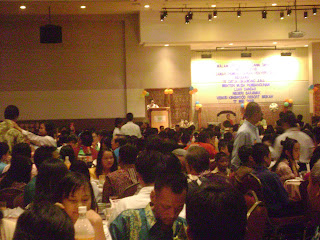

 The land mark for Mentakab, UMNO Building (Above), Old Shophouses with attractive paint and decoration (Centre), Abu Bakar Mosque (Below)
The land mark for Mentakab, UMNO Building (Above), Old Shophouses with attractive paint and decoration (Centre), Abu Bakar Mosque (Below)From my arrival until I left Mentakab, I still lost on the icon for this small town. I know that the Temerloh district is famous for it Ikan Patin (Pangasius Sutchi). So maybe the same icon for Mentakab. This town is well developing mostly because it was of the one stop for traveler from Kuala Lumpur to Kuantan. An army camp is situated about 5 km from the town and play its roles to rejuvenate the developments. Anyway, oil palm, rubber and logging are still the major industry in this town.
Local food is of course glamour for it Ikan Patin.
Mentakab was once considered by the State Government in the year 1901 to be the new centre of all administrative works in the state of Pahang. However, due to a problem of uneven land, Kuantan was to be the new capital of the state.
This town is well connected by road, around 121 km from Kuala Lumpur and 136 km from Kuantan. Railway is also available but reported to connect only to Kelantan.
Amazingly, one of the country's fastest growing private universities, the Open University Malaysia's (OUM) is located at Mentakab.


Streets in Mentakab


Amazingly, this small town needs parking coupon to park your car. Be careful, or otherwise you will compouned RM 10.00. Oh Ya! I drived around the town actually...
Muslim is majority, but Mentakab also have temples and churh. The symbols of Malaysian unity....

This building is the tallest building in Mentakab

Open University Of Malaysia, Mentakab, Pahang

Lanchang Town (Above) and Karak Town (Below), the one stop from KL to Mentakab
Main access to Mentakab, Mentakab Bus Station (Above), Access road to Mentakab Railway Station (Centre), Jalan Kuantan - Kuala Lumpur (Below)
After two nights in Mentakab, I feel that Mentakab has his own identity, history and beauties that yet to reveals. And before left Mentakab, I took two bottles of Stout.... He he
















































